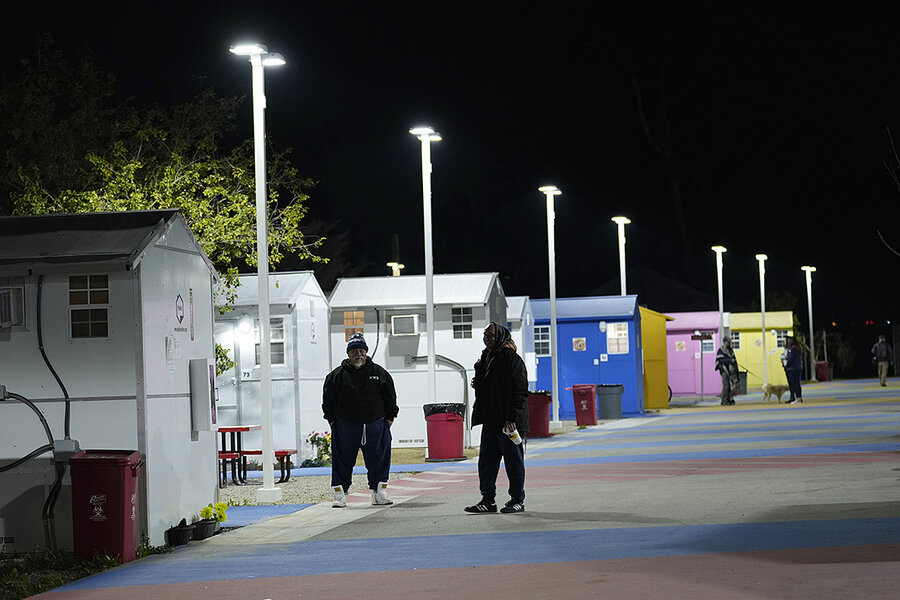For more than a decade, California has topped the list of U.S. states with the most people experiencing homelessness. Despite the state putting billions of dollars toward the problem, the number of those without housing keeps ticking up.
A new landmark survey of California’s homeless population reveals who is homeless in the state, and why – and dispels some common myths along the way. The findings offer clues about how to build better programs to ameliorate the homelessness crisis in the Golden State and across the country.
Why We Wrote This
A story focused on
California harbors 30% of the nation’s homeless population. The lead researcher of a landmark study on who is homeless in the state, and why, shares possible solutions.
High housing costs are the leading cause of homelessness, more so than mental health or drug abuse, according to the new study. Other revelations: Ninety percent of the homeless population in California is from California, and they are older – nearly half are over age 50.
The study provides a half-dozen policy recommendations with an emphasis on closing the gap between income and housing costs.
“We need to move away from some of the mythology around [homelessness] and focus on real solutions,” says Margot Kushel, the study’s principal investigator and director of the Benioff Homelessness & Housing Initiative at the University of California, San Francisco. The Monitor explores this issue in a Q&A with Dr. Kushel.
For more than a decade, California has topped the list of U.S. states with the most people experiencing homelessness. Despite the state putting billions of dollars toward the problem, the number of those without housing keeps ticking up. But a new landmark study could lead the way out of this morass.
The recent survey of California’s homeless population reveals who is homeless in the state, and why – and dispels some common myths along the way. The findings offer clues about how to build better programs to ameliorate the homelessness crisis in the Golden State and across the country.
High housing costs are the leading cause of homelessness, more so than mental health or drug abuse, according to the study. Other revelations: Ninety percent of the homeless population in California is from California, and they are older – nearly half are over age 50.
Why We Wrote This
A story focused on
California harbors 30% of the nation’s homeless population. The lead researcher of a landmark study on who is homeless in the state, and why, shares possible solutions.
Researchers at the Benioff Homelessness and Housing Initiative at the University of California, San Francisco surveyed 3,200 people experiencing homelessness, and conducted 365 in-depth interviews, for the largest and most comprehensive examination of homelessness in three decades.
California harbors 30% of the nation’s homeless population, which reached an all-time high last year. The new study provides a half-dozen policy recommendations with an emphasis on closing the gap between income and housing costs, including increased access to affordable units, expanding rental subsidies, and financial support to prevent housing loss.
The Monitor’s Ali Martin spoke with Margot Kushel, director of the Benioff Homelessness & Housing Initiative and the study’s principal investigator. The conversation has been edited for clarity and length.

Margot Kushel is director of the Benioff Homelessness & Housing Initiative at the University of California, San Francisco.
What was the study’s most important takeaway?
Nine out of 10 people in the study lost their stable housing in California; three-quarters were living in the same county where they lost their stable housing. It’s really important to realize that these are Californians who have been internally displaced by remarkably high housing costs, the highest in the country.
If we have to put our finger on the single biggest cause of homelessness, whether or not people had disabling conditions, the single biggest driver was the inability to afford housing. At the end of the day, people just couldn’t afford their housing.
What can the rest of the country learn from California on this subject?
Frankly, we know that the places with high per capita rates of homelessness – New York, California, Oregon, Washington, Arizona, Florida, Nevada, Hawaii – they all share something in common, which is a really low amount of housing for the lowest income renters. So there’s this disconnect between the availability of housing for poor people and the number of very poor people.
California is very similar to much of the West Coast in that most people experiencing homelessness are unsheltered [living in an area not meant for human habitation]. I’m sure if this study was replicated up and down the West Coast, whether Nevada or Washington or Oregon or Arizona, even Texas, I think you would find relatively similar things.

Two residents of a tiny-homes community, built for people experiencing homelessness, stand outside a row of the units in Los Angeles, Jan. 24, 2023.
What sort of financial supports does the study suggest?
People are being industrious, right? They’re crowding in, they’re doubling up, they’re doing whatever they need to do. But I don’t really see a way forward without multiple things happening at once: the cost of housing coming down, but that housing almost certainly is going to need to be subsidized.
Right now in our country, only one in four people who meet the very strict criteria for having vouchers receive them for rental subsidies. There’s some people who really do need rental assistance but don’t qualify. Some people who have the vouchers in these high cost regions can’t even use them, because there’s no place to use them. That is something that Congress could change. And it would have a transformational impact on people’s ability to be housed because it would also provide a steady funding source for people who are creating housing. Realistically, there’s no way out of this crisis on a permanent basis without recognizing that as long as we have people with such low wages or benefits and such high housing costs, something has to give.
The other thing we learned is the incredible cost of homelessness. Obviously the most important cost is the cost to people who survive it. The amount of violence people experience, the way that their health fell apart. It’s a really, really searing, terrible experience. But there are lots of other costs, like we’re spending money on shelters, we’re spending money on policing, we’re spending money on jail stays that are doing nothing to promote public safety, just cycling people in and out of our jails. We’re spending money on emergency department visits and hospitalizations that would never have had to happen, if someone had housing.
How do mental health supports fit in with the recommendations?
It’s not a surprise to anyone that folks experiencing homelessness are disproportionately impacted by mental health problems and substance abuse problems. I’m not denying that in any way, shape or form. What I’m saying, and I say this both as a researcher who’s looked at different models and as a clinician who treats people with mental health and substance use problems, is none of that works if you ultimately don’t have housing. Many people are in the hospital for three days and then there’s no hospital bed so they get sent out and even the really prolonged hospitalization, seven weeks, eight weeks, 10 weeks – you’ve got to have a place to send someone to when they leave.
I do think that much of this housing will need to have really low-barrier access to robust mental health and services. It’s been proven again and again that if you provide the right services and support for people, their housing sticks more. And if you start with the housing and if you make those services voluntary, but you make them really easy to use, people take them up and use them. Absolutely, we need more services, but you can’t ask the health care system to solve a housing problem.
Have you taken these policy recommendations yet to anyone who can do something about them?
We’re starting to have conversations at local, state, and national levels. I suspect that many policymakers know this and want to do the right thing. And it’s important that the general public understands that this is solvable. That we will all benefit when we solve this problem.
Veterans Affairs is a fantastic model. There has been political will around ending veterans homelessness [which has decreased by 55% since 2010]. They are sticking to the evidence. Every single veteran homelessness program adheres to housing first principles. Housing first is imminently flexible: Some people just need a small rental subsidy. Some people just need a short term boost to get back into the job market. Some people need extensive services and support. That’s what they’re doing. It’s exactly the opposite of one size fits all. But it recognizes that if we really want to help people heal, if we really want people to engage in treatment, then housing is the base of all of it.
>>> Read full article>>>
Copyright for syndicated content belongs to the linked Source : The Christian Science Monitor – https://www.csmonitor.com/USA/Society/2023/0713/Busting-homeless-myths-Q-A-with-a-California-researcher?icid=rss































